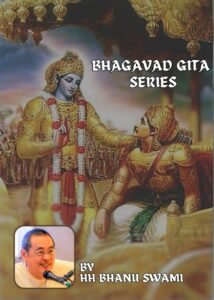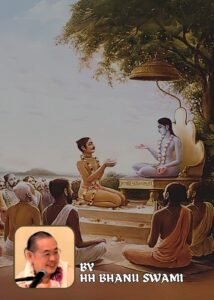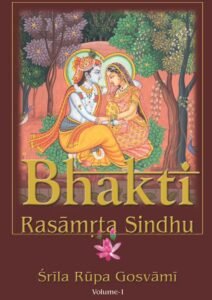Srimad Bhagavatam – 1.13. 51~53 | HH Bhanu Swami Maharaj | ISKCON Chennai | April 14, 2025|
Om Namo Bhagavate Vāsudevāya
Om Namo Bhagavate Vāsudevāya
Om Namo Bhagavate Vāsudevāya
nama om vishnu-padaya krishna-preshthaya bhu-tale
srimate bhaktivedanta-svamin iti namine
namas te sarasvate deve gaura-vani-pracharine
nirvishesha-shunyavadi-pashchatya-desha-tarine
jaya sri-krishna-chaitanya
prabhu nityananda
sri-adwaita gadadhara
shrivasadi-gaura-bhakta-vrinda
Hare Krishna Hare Krishna Krishna Krishna Hare Hare
Hare Rama Hare Rama Rama Rama Hare Hare
Reading from Srimad Bhagavatham Canto 1 Chapter 13 Verse 51.
ŚB 1.13.51
धृतराष्ट्र: सह भ्रात्रा गान्धार्या च स्वभार्यया ।
दक्षिणेन हिमवत ऋषीणामाश्रमं गत: ॥ ५१ ॥
dhṛtarāṣṭraḥ saha bhrātrā
gāndhāryā ca sva-bhāryayā
dakṣiṇena himavata
ṛṣīṇām āśramaṁ gataḥ
Synonyms
dhṛtarāṣṭraḥ — Dhṛtarāṣṭra; saha — along with; bhrātrā — his brother Vidura; gāndhāryā — Gāndhārī also; ca — and; sva-bhāryayā — his own wife; dakṣiṇena — by the southern side; himavataḥ — of the Himālaya Mountains; ṛṣīṇām — of the ṛṣis; āśramam — in shelter; gataḥ — he has gone.
Translation
O King, your uncle Dhṛtarāṣṭra, his brother Vidura and his wife Gāndhārī have gone to the southern side of the Himālaya Mountains, where there are shelters of the great sages.
Purport
To pacify the mourning Mahārāja Yudhiṣṭhira, Nārada first of all spoke from the philosophical point of view, and then he began to describe the future movements of his uncle, which he could see by his foreseeing powers, and thus began to describe as follows.
HH Bhanu Swami Maharaj:
So these verses are describing what happened to Dhrtarashtra after he left the house. We see that Dhrtarashtra for all of his life, was involved in politics. This resulted in the battle of Kurukshetra, and all his sons died. So he was staying in the house of the Pandavas, but there were no more politics for him. But he also wasn’t doing anything spiritual. So Vidura came and gave him good advice. The only remedy for his situation was to practice spiritual life. Throughout his life, by doing his politics, he committed so many sins and aparadhas. And one has to suffer for that. Of course, normal people don’t even consider that.
So one is, we have to atone for our sins in order that we don’t suffer in the future. The other, of course is that, we should go beyond that, and that is, we should try to get out of the material world. But when Dhrtarashtra was sitting in the house of the Pandavas, he was doing nothing. He couldn’t accrue anything material. He didn’t atone for his sins. Nor did he try to give up his material attachments. So he was in a very miserable condition. So Vidura understood this, and therefore he gave him some good advice. Vidura had tried to give advice before, but Dhrtarashtra had refused. Still, he made this attempt. So this shows his great mercy. In spite of the fact that he was insulted by the Dhrtarashtra and his sons, he was willing to give mercy to Dhrtarashtra.
But the mercy of the devotee is different than the mercy of a materialist. The mercy of a materialist was to give him some money so he can live independently of the Pandavas. The mercy of the devotee is to tell him to leave everything. So leaving the palace and leaving all the comforts is one step. So detachment is necessary for advancement, but we have to do more than become detached. So, the Vedic literature describes different spiritual processes. These processes will give us atonement for all the sins, plus it will get us out of the material world. Simply doing karma yoga will not get you out of the material world. If we do Jnana yoga, ashtanga yoga, or bhakti yoga, we get rid of the karmas, plus we get out of the material world.
So here we see that Dhrtarashtra was practicing yoga. Though he was a Kshatriya, he also had some knowledge of the practice of yoga. And he was able to practice. So through this practice, eventually, we can separate the atma from the material body. We can destroy all karma. So this is a physical process. And for people who are involved in the physical body, it looks like a practical process. However, it’s also rather difficult. So we see that he was not eating, only drinking water. He was living in the forest. He was practicing yamas and niyamas. This is the preparation for yoga practice.
So, this is the first step in making the body peaceful. Then one practices asanas to make the body healthy. Then one practices pranayama to begin to control the mind. So gradually, one can get control of the mind, and finally stop all the functions of the mind. When all the mental functions completely stop, the only thing left is atma. So that is called samadhi. If one reaches that state, one is free from the material body. One dies in that state, one can get liberation. So we see many people, or some people, practice this. But it’s also very difficult for most people. And even Arjuna finds it difficult. So, though it is a process to get rid of the material body and get out of the material world, it’s difficult for most people.
So, though the process is described and praised in Vedic literature, including the Bhagavatam, ultimately Krishna rejects it. And instead he recommends the process of bhakti. So, this is the conclusion of Bhagavad Gita, it’s also the conclusion of Bhagavatam. So of course Krishna speaks this message in Bhagavad Gita, and Krishna also speaks to Uddhava, the same message in Bhagavatam. So bhakti is an easier process of stopping birth and death. However, that is not the goal of bhakti. That is the goal of yoga. So some people will think, well bhakti is inferior because it doesn’t strive for liberation. But this is a mistake, because bhakti has a higher goal than liberation. So because it has a higher goal, it includes all the advantages of liberation. So for that reason, Krishna himself recommends the process of bhakti.
So as I mentioned, whatever yoga can give, bhakti can give. That means that bhakti frees you from the material world. The devotee is eternally beyond birth and death. But then what’s the difference between mukti and ashtanga yoga and bhakti? So by bhakti, not only you get out of the material world, no more birth and death, but you develop a spiritual body. That spiritual body is beyond birth and death. So of course one can choose, I will get out of the material world, no more birth and death, no body, or I’ll go beyond birth and death with a body. So the devotee chooses liberation with a body. Why? Because with that body he can experience the highest bliss. What is that bliss? That bliss is, using that spiritual body to please the supreme lord.
Now why should we please the Supreme Lord? Supreme Lord is the source of everything. He’s the source of our consciousness, He’s the source of our experience, He’s the source of our bliss. So by serving the Lord, we experience the highest bliss. What about the Yogi with no body? Without a body he cannot serve the Lord. Without spiritual eyes, he cannot see the Lord. So what does he do? He is simply aware. But not aware of anything. Because no eyes, nothing is there. So the only advantage is, he’s beyond birth and death. No more ignorance, no more karma, no more body.
So the atma in that position is free from body etc., but he is not functioning to his full capacity. We say he’s in that position of sat, simply being eternally existing. As Krishna teaches Arjuna in second chapter of Bhagavad-gita you are atma. Atma has no birth, no death etc. So that’s what he realizes. But though the atma is an amsa or portion of the Lord, expansion from the Lord, small particle, he has a greater capacity. His capacity is, he can be like the Lord. So he can get a form like the Lord. He gets a place like the Lord’s place. He gets powers like the Lord. But he uses all of this to serve the Lord. And through that then he gets that bliss. So the result is that not only he gets a body, spiritual body like the Lord’s, he actually becomes superior to the Lord.
So by nature he’s just a small particle. Through devotional service he’s able to control the Lord. So, the Jiva has a very very great capacity. But the capacity does not manifest unless one performs bhakti. So that is why the process of bhakti is recommended. It allows the Jiva to attain his highest capacity.
Hare Krsna!
Q&A
1) Maharaj, [not audible] here Dhritarashtra is getting associated with Vidura and Vidura is guiding him what to do, what not to do. But Vidura is guiding him to perform the Ashtanga Yoga to Dhritarashtra. Is it because of that he’s so much attached to his family affairs and other things?
So we know that bhakti requires qualification. If we’re not qualified for bhakti we go for karma yoga, jñāna yoga or ashtanga yoga. So of course Dhritarashtra wasn’t even into karma yoga because it’s so sinful. But at least he should become detached. So therefore he got this type of practice. And of course fortunately Dhritarashtra was willing to practice. Of course it would have been much easier if he says don’t do anything just worship Krishna, stay in the palace and worship Krishna.
Vidhura was a great devotee. But he also knew that Dhritarashtra couldn’t follow such an instruction. Therefore, he gave him this instruction.
Devotee: Can I also say that because you are saying that Dhritarashtra would have worshipped Krishna in the palace itself. So Vidura didn’t say because Dhritarashtra is in a comfort zone. So unless and until one comes out from the comfort zone it becomes very difficult for him to practice.
HH Bhanu Swami Maharaj: Of course practicing bhakti requires some detachment. But at the same time bhakti can develop in the most difficult circumstances. Prahlad was in the palace of Hiranyakasipu [laughs].
Mrugari the hunter was in the forest killing animals. So in some cases the devotees are very merciful and in very difficult circumstances devotees develop bhakti. If one is very attached whatever mercy you give it is very difficult.
And therefore we have the 10th aparadh to have too much material attachment. So for such people they have to go gradually. One way of course is gradually do bhakti. Another course is to go through ashtanga yoga or jnana or whatever to get to bhakti.
2) Maharaj you were explaining regarding this liberation. Not aware of anything that is his awareness in liberation. This is almost like a deep sleep. In the deep sleep he is not aware of anything what is happening around him. So can you say that liberation is like going to deep sleep?
It is quite similar. But deep sleep is not permanent. Why? Because you still have your subtle body, you still have your mind, you still have your vasana, you still have your karmas.
They are just in abeyance for a little while. So in the 4th state that is liberation then there is no more subtle body, no more mind, no more karmas, nothing. And it is permanent.
3) Maharaj, we see when kings and many people went for the vanaprastha ashram so sometime they took their wives also. Like in case of Prithu Maharaj, Archi went.
What in case of Vidura, the wife of Vidura where I mean to say no description is there. So she went or she remained there with Pandavas?
We don’t hear much about Vidura’s wife anywhere because he was on pilgrimage also without his wife apparently. One can practice vanaprastha with or without the wife also. We see that Bharata went to the forest but no wife [Laughs].
4) Hare Krishna Maharaj. Two things Maharaj. One, we see that Vidura is a great devotee.
And yet he, you were saying, you Maharaj you told that he preached according to Dhritarashtra’s qualification. But in Kali Yuga, most people are not qualified. But we have no other option to preach. We have to tell them about only devotional service.
Yeah, so in Kali Yuga, there is no alternatives. In other yugas, there were alternatives.
And we see that it was not difficult for Dhritarashtra to practice yoga and just drink water even. So we preach bhakti, we can’t preach anything else. But if they are not qualified for bhakti, what do we do? Of course, one is let them practice varanashram but then how do we do that because there is no system. So we cannot preach to the faithless. So all we can do is expose them to bhakti.
Through that exposure, eventually they get faith. The interesting thing is also that there is an effect that happens in a group of people. So we have a group of people and we have a small amount of people thinking one way it doesn’t influence so much. But when it reaches a certain level, I don’t know the exact amount, maybe 3% or 5%, then it starts to influence other people. Even when they don’t do anything [laughs], it influences people.
And that happens in the material world itself. So in the same way, that when the devotees reach a certain percentage of the population, it does have an influence. Their mere presence is a blessing for everybody.
5) Thank you Maharaj. And Maharaj, we also see that Dhritarashtra was a very, very offensive person. The untold miseries that he placed upon the Lord, upon the devotees of the Lord and also the Lord. So Maharaj, we read 10 offenses every day. And we who are practicing devotional service, we have to be so careful to avoid those offenses. And we see the case of Bharat Maharaj that he got attached to a deer in his practice.
But here Dhritarashtra has been committing so many offenses and not really practicing devotional service, but he practiced Ashtanga Yoga and got perfection. So how do we understand? Is it that he received a great amount of grace of Vidura and that kind of balanced his offenses out? Or how did he atone for the offenses that he committed against the devotees?
So the main problem with offenses is that it obstructs bhakti. Of course by offending devotees we also get bad karma. But of course bad karmas can be eliminated by atonements, which is Karma Yoga, by Jnana or Ashtanga Yoga. But it’s also a long difficult process.
By the process of bhakti, the aparadhas and the sins are easily and quicker. They are destroyed quicker. But if we have no faith in bhakti, we have no choice [laughs].
So somehow or other he was able to practice this Ashtanga Yoga. We can assume that because he could do it, he must have had some previous punyas to do that, maybe previous lifetimes.
Of course we also don’t know ultimately what was his final destination. At most it was liberation. Maybe not even that we don’t know. But we can say even that he got by mercy of Vidhura.
6) Hare Krishna Maharaj. Maharaj in ISKCON we see that there is very clear definition of Brahmachrya, Grahasta and Sannyasi ashram but not so much emphasis on vanaprastha ashram. So is vanaprastha ashram relevant in current time and if there is any specific things regarding vanaprastha ashram Maharaj?
Of couse in the Varnasrama system renunciation of people who are not brahmanas would be Vanaprastha and Sanyasa ashram was only allowed for brahmanas.
So in ISKCON we don’t really follow that system. So at the same time, we can say the procedures can be followed to some degree. That is after the children are grown up and they support themselves, then the parents should separate and they should practice more spiritual life.
But to follow the practices for any ashram that is described in Bhagavatam, third canto or eleventh canto, is very difficult for anybody. Whether it is brahmachari, grahastha, vanaprastha or sanyasa.
7) We heard in today’s class that this jiva, though it is small and insignificant yet it has great capacity and by devotional service can even control the Supreme Lord. So my question is that when we talk about controlling the Supreme Lord, is it applicable only for those who are at the prema level or even at sadhaka level there is some degree of control?
So, of course, in Nectar of devotion, Rupa Goswami classifies Krishna Akarshani and bringing Krishna under control as a symptom of prema. In prema, the devotee has no material desires at all. He completely gives everything to Krishna and Krishna gives everything to the devotee.
However, even if the devotee is beginning the practice, maybe practicing mixed bhakti, the Lord is still more attracted to that devotee than He is attracted to karma yogi, jñāna yogi or ashtanga yogi. And thus the Lord was very attracted to Gajendra, even though he was just doing mixed bhakti.
Devotees: Grantharaj Srimad Bhagavatham Ki Jai!!! HH Bhanu Swami Maharaj Ki Jai!!!


